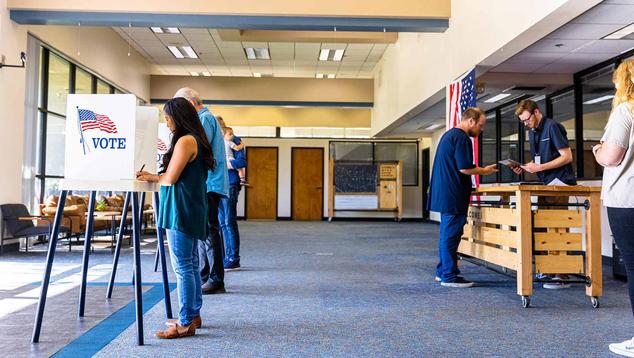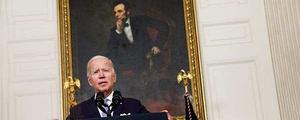Story Highlights
- More millennials identifying as independent as they get older
- Generation X maintaining higher levels of independent identification
- Republican identification much higher among older generations
WASHINGTON, D.C. -- Historically, Americans have had weak attachments to the two major U.S. political parties in young adulthood, but as they get older, they usually became more likely to identify as a Republican or a Democrat. That historical pattern, evident in the Silent and baby boom generations, appears to be changing. Generation X and millennials, who are now middle aged or approaching it, have maintained or even expanded their identification as political independents in recent decades.
Currently, 44% of Generation X identifies as political independents, which is unchanged from three decades ago, when the first part of the generation was entering adulthood. The majority of millennials, 52%, are independent, and that percentage has increased by five percentage points in each of the past two decades.
Meanwhile, Gallup data show far lower, and declining, proportions of independents among the Silent Generation (now 26%) and baby boomers (now 33%), consistent with the historical pattern.
Members of Generation Z who have reached adulthood match millennials in the percentage of political independents, at 52%.
The data also reveal that each younger generation has had a greater proportion of independents throughout their lives than the prior generation did, even at similar stages in their life. For example, the 44% of Generation X (now aged 42 to 57) that currently identifies as independent is 10 points higher than the 34% of baby boomers who said they were independents in 2002 (when they were aged 38 to 56).
These emerging generational patterns of party identification help explain why independent identification has reached levels in the past decade never seen before in Gallup polling. Since 2011, 40% or more of U.S. adults have identified as political independents in nearly every year. Before that year, that level had never been reached.
Independent Identification Varies Inversely With Republican Identification
Whereas younger generations tend to be more politically independent than older generations, older Americans are much more likely to identify as Republicans. In fact, Republican identification is most common among the oldest generation of Americans -- the Silent Generation, at 39% -- and is less common at each lower rung on the generational ladder, down to 17% among Generation Z.
Democratic Party identification is more uniform across the five generational groupings, ranging between 27% and 35%.
These results are based on aggregated data from 2022 Gallup surveys to date, encompassing more than 6,000 interviews with U.S. adults and at least 500 in each generation. The results for 2022 are similar to those for 2021, which are based on even larger samples.
Gallup also analyzed its 1992, 2002 and 2012 data to show how party identification has changed among the generations over time. The most notable changes in recent decades are that the Silent Generation has become increasingly Republican and less independent, while independent identification among Generation X and millennials has held steady or increased, compared with when the groups first entered adulthood.
The following sections show the trends in party identification for each generation over the past 30 years. There are no trend data for Generation Z because no one in that generation had reached adulthood until 2015.
Silent Generation
Members of the Silent Generation were born between 1928 and 1945 and, therefore, are primarily between the ages of 77 and 94 today. The group has been less likely to identify as independents than other generations over the past 30 years and is even less likely to do so today.
Since 1992, the percentage of Silent Generation members who identify as political independents has decreased from 35% to 26%, which has been accompanied by an equal increase in Republican identification.
Over the past 30 years, the proportion of Silent Generation people who identify as Democrats has been relatively stable.
Baby-Boom Generation
The pattern in party identification among baby boomers, born between 1946 and 1964 and aged 58 to 76 today, is largely similar to that for the Silent Generation. Fewer baby boomers today (33%) than in 1992 (40%) identify as political independents, with most of that change offset by an increase in Republican identification, from 29% to 35%. The 32% of baby boomers who identify as Democrats is largely unchanged over the past 30 years.
Baby boomers' party preferences have been evenly split over the past three decades.
Generation X
Generation X, whose members were born between 1965 and 1980 and are aged 42 to 57 today, has a higher proportion of independents than preceding generations and, unlike those generations, that percentage has not shrunk over time.
In 1992, when only about half of Gen X had reached adulthood, 44% identified as independents. Ten years later, when all generation members were at least 22 years old, a slightly smaller percentage, 39%, said they were independent. But in both 2012 and 2022, the proportion of Generation X members who are independent has returned to the mid-40% range.
The adult members of Generation X in 1992 were more likely to identify as Republicans than Democrats, 32% to 24%. This group came of age when Republicans held the White House for 12 years between 1981 and 1992. Over time, and as more of Generation X reached adulthood, Republicans and Democrats have claimed roughly equal proportions of the generation, including 30% of the former and 27% of the latter this year.
Millennial Generation
Millennials, born between 1981 and 1996 and aged 26 to 41 today, have become increasingly independent since 2002, when the oldest members of the generation were first turning 18. That year, 42% of adult millennials were independent. Ten years later, when all but the youngest millennials were adults, 47% identified as independent. Now, a 52% majority of the group does.
Millennials have been more likely to identify as Democrats than Republicans over the past 20 years, but fewer align with either party than did 10 and 20 years ago.
Bottom Line
Younger generations of U.S. adults are much more likely than older generations to identify as independents and, to this point, Generation X and millennials have become no less likely to do so as they have gotten older, in contrast to the generations that preceded them.
The youngest adults, those in Generation Z, are as likely as millennials to think of themselves as independents. In fact, like millennials, more describe themselves this way than identify with either political party.
These population trends appear at odds with the political parties' actions, as they have seemingly tried to appeal more to their own bases than to the larger group of unaffiliated voters. This disconnect may explain low levels of trust in government and poor views of both parties in general. While Republican messaging in recent decades may have increased the party's support among older generations of Americans in recent decades, it may have cost the party support among younger generations, with only about one in five adults younger than 41 identifying as Republican.
The trends to date for Generation X and millennials do not preclude their showing declining political independence as they continue to age. However, even if those generations become less likely to identify as independents in the future, they will still likely have higher proportions of independents than members of their preceding generations had at similar points in their lives.
To stay up to date with the latest Gallup News insights and updates, follow us on Twitter.
Learn more about how the Gallup Poll Social Series works.



